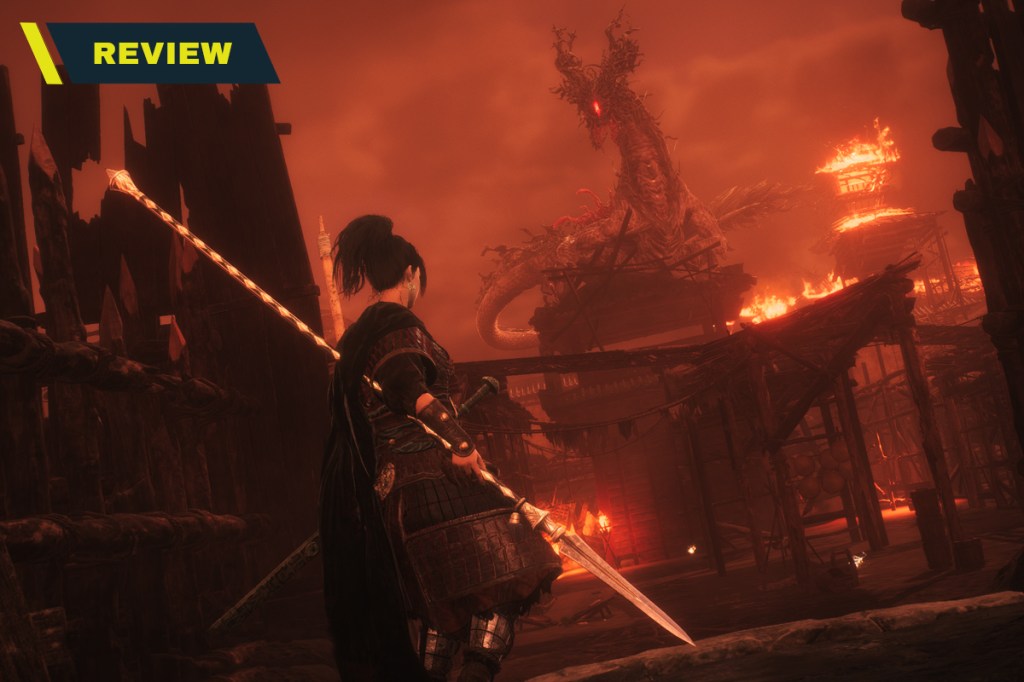Team Ninja was one of the few teams to take the soulslike formula into its own direction, as it beautifully combined FromSoftware’s landmark blueprint with its own particular brand of action games. It worked out wonderfully for the two Nioh titles, and Team Ninja has taken the same approach for Wo Long: Fallen Dynasty. Although there’s undeniable overlap between the two, Wo Long is more than a reskinned Nioh game, as its focus on parries shows that studio is a multifaceted master of the blade.
That central parry mechanic is the biggest differentiator between the two and what makes Wo Long so special. Instead of being a high-risk option meant only to be used sparingly like it is in many other titles, Wo Long’s combat revolves around deflecting oncoming attacks.

The timing window, thanks to feedback from the demo, is surprisingly generous, yet still requires skill to pull off consistently because of how varied the attack speeds are. Some do need to be deflected quickly, but the game intelligently has plenty of moves that punish those who parry in a panic. This is most clearly seen in its unblockable Critical Blows that force players to play patiently and learn the timing. It’s incredibly responsive, as Team Ninja games usually are, and the loud and distinct sound effect combined with learning the proper rhythms makes Wo Long’s deflecting system robust enough to hold up the entire game.
Deflecting is immensely rewarding in its own right, but it also plays an important role in other areas of its gameplay. Instead of a stamina bar, Wo Long has a two-sided meter that rises as players land attacks and parries and falls when taking damage and using heavy attacks, special moves, or magical spells.
While it can seem restrictive to tie so much to one resource, it instead streamlines everything and begins to open up once it’s clear that constantly spending and saving meter is the key to success. By directly tying it to offensive and defensive play, it’s designed to get players to become more active and well-rounded, and it’s never unfair since enemies, for the most part, also play by these same rules. It’s all beautifully interwoven and while it has echoes of games like Sekiro: Shadows Die Twice and Nioh, it’s unique and good enough to stand out.

Its Morale system is also rather different. Every character has its own stage-specific power level that grows after getting kills — even foes that best the player get a little boost. Dying resets that Morale rank and means players have to start from the bottom after taking one too many blades to the face. However, that floor can be raised by posting flags in certain places.
These systems encourage users to engage with enemies and thoroughly search levels for areas to plant flags since finding all of them makes it impossible to drop below the highest enemy rank. Team Ninja also uses these levels to signal where to go since seeing enemies with an obscenely high Morale rank means that there’s a better route elsewhere. Having to grind after an untimely death can occasionally be frustrating, but it gets players to explore its stages and get better in order to succeed while also providing a generous enough safety net with the flag system.

Since the Morale rank grows with every fight, a skilled player can snowball and become a nearly unstoppable powerhouse, which highlights how comparatively easy Wo Long can be at times. A lot of this manifests in how the game insists on spawning in an A.I. buddy or two in almost every main mission. These characters are effective soldiers and can, more importantly, distract enemies long enough to allow players to get a few cheap shots in. While acceptable in moderation or through a consumable item, its overreliance on companions takes away from the rewarding combat since it removes the necessity to study every intricacy and pattern since fights become a lot easier to brute force.
Bosses are not immune to this and are the biggest casualty of this oversight. Many of them are designed incredibly well and have a ton of unique attack patterns, but almost always having another character or two there means they are artificially more forgiving. Many can easily be killed on the first or second try, which is not nearly as satisfying as overcoming through sheer determination and hard work. Taking down a boss doesn’t always feel like it was earned and that feeling has been so crucial to Team Ninja’s games. It’s disappointing that the otherwise meticulously designed bosses aren’t better tests of the precise mechanics.
However, even a few of the climactic one-on-one duels are on the easier side and show how uneven Wo Long’s difficulty can be. There’s only one truly spectacular, well-optimized fight that demands that players learn and adapt, but it’s in the middle of the game and bookended by a slew of big battles that oscillate between painless and somewhat difficult. It’s not a steady climb, and while even the least compelling bosses here are better than the best bosses in most games, the way many are tuned means they don’t realize all of their potential. Wo Long is not a cakewalk, as even the most braindead grunts can still be deadly and every fight requires a baseline level of competence and brainpower, but it’s not as finely honed as it should be.

Some of these shortcomings can be surprising because of how similar it is to the studio’s other games. Wo Long still has an overly serious and poorly told story with a shallow protagonist, an overstuffed gear system, and art direction that, outside of monster designs, is rarely more than competent, which also mostly applies to both the Nioh and Ninja Gaiden games (although the latter didn’t have a gear system). Team Ninja’s combat chops are still among the best in the industry and that is not a small feat, but it would be great if the developer could start branching out and take its knack for deep mechanics into a slightly newer direction.
Even with its small handful of inconsistencies, Wo Long: Fallen Dynasty is not a Chinese palette swap of Nioh. They may both be third-person melee-focused action titles set in Asian countries and have pseudo-historical, mythological backdrops, but Wo Long carves its own path because of its distinct and rich combat system. Parrying is always fulfilling and the game’s many new systems are built around that rock-solid foundation. And while not quite the sharpest sword Team Ninja has crafted, it’s still as deadly as ever.
SCORE: 8.5/10
As ComingSoon’s review policy explains, a score of 8.5 equates to “Great.” While there are a few minor issues, this score means that the art succeeds at its goal and leaves a memorable impact.
Disclosure: The publisher provided a PlayStation 5 copy for our Wo Long: Fallen Dynasty review. Reviewed on version 1.002.000.











